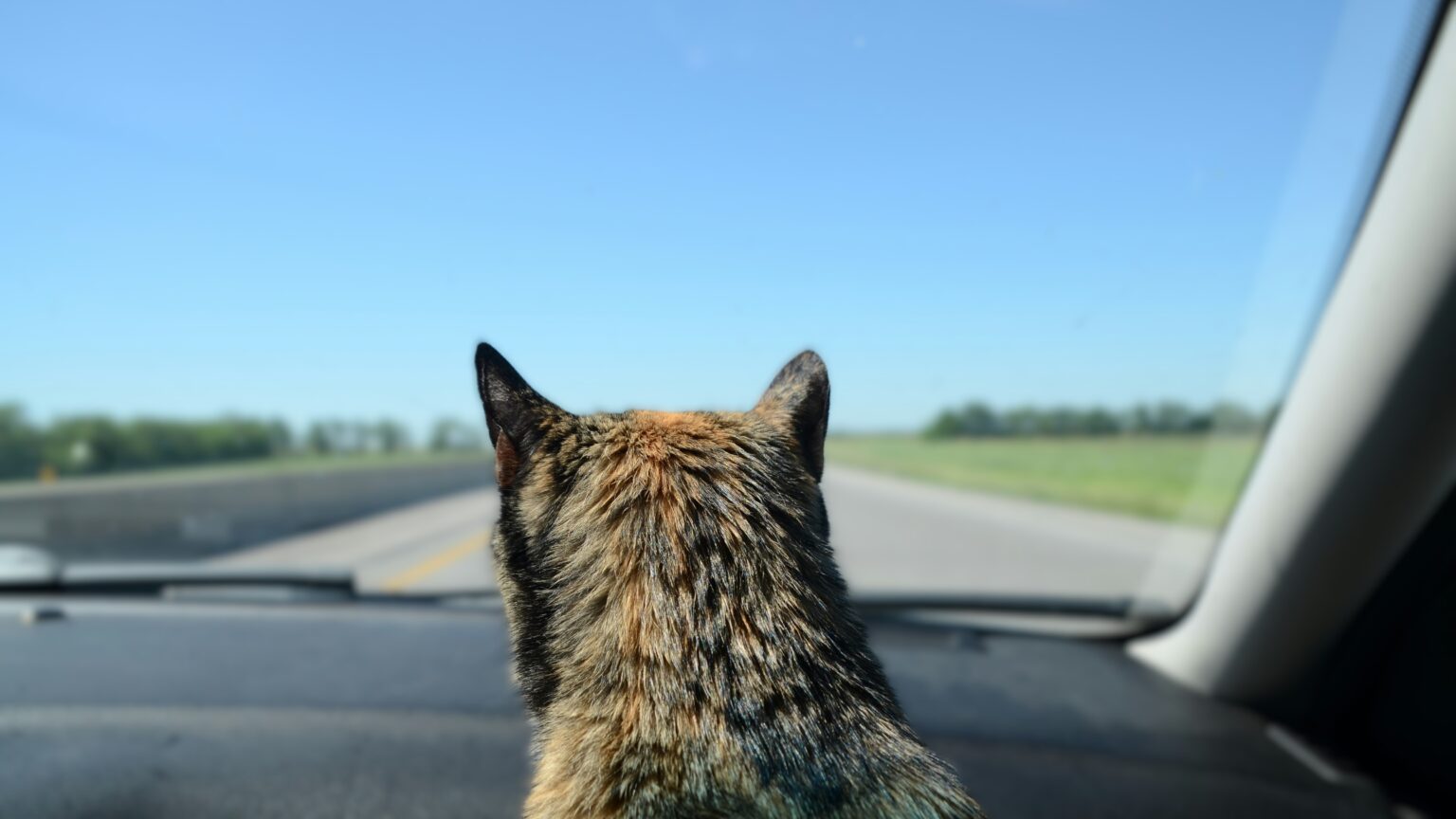Ahhhh life on the road – the ultimate adventure.
But wait, what about your furry feline family members?
Content warning: cat puns ahead.
As I have discovered over the past four years, travelling long-term with cats can be a real challenge. Mix equal parts cute with chaos and you have the recipe for the early onset of grey hair. So, to help other cat mums and dads around the world, I thought I would share some pearls of wisdom I have gained over the years. I hope these tips and tricks will help make sure your van life with cats is less hiss-terical and more purr-fectly enjoyable.
The right vehicle keeps everyone feline fine
When you’re packing your life into a van, space is precious. Now, throw a couple of cats into the mix, and you’ve got yourself a potential feline riot if the quarters are too cramped. Opt for a van with enough room for you, your gear, and your cats to have their own little nooks. Remember, cats are territorial creatures. They’ll want a spot that’s theirs, whether it’s a cosy corner with a blanket or a special perch to watch the world zoom by. Also, be aware that some cats can get travel sick and watching the world whizz by out of a window can make them worse. Consider semi-transparent window blinds or creating a dark and comfortable space for them that doesn’t hinder your view of the road.
Purrpare your cats for the road
Cats aren’t exactly known for their love of car rides. Unless your cat is a rare road warrior, you’ll need to ease them into the idea of van life. Start with short trips to get them used to the van. Gradually increase the duration, and don’t forget to bring along their favourite toys and some treats. By the time you’re ready for the big adventure, they’ll be more comfortable with the idea of their new, mobile home.
The Litter Box Dilemma: no kitten around
Ah, the litter box—every cat owner’s favourite topic. In a van, finding the right spot for the litter box is crucial. It needs to be accessible for your cats but not in your way. Consider placing it in a concealed area like under a seat or in a cabinet with a small opening. You can even get creative and use a large storage container with a cut-out door as a hidden litter box. Just make sure it’s easy to clean because, let’s face it, nobody wants to deal with litter spills in a tiny living space.
One of my cats tends to need “the loo” at the most inconvenient of times (going around a roundabout or about to board a ferry). So, make sure it is secure and does not move around too much. Also, consider the type of litter you will use. If you’re travelling to different countries, get your cats used to a few different types (wood pellets, sawdust, clumping litter). You may not always find your cat’s preferred litter type.
Finding the purrfect temperature
I can’t stress this point enough! Cats are sensitive to temperature changes, and in a van, you’re at the mercy of the weather. Invest in good insulation and ventilation for your van. Portable fans, window shades, and a small heater or cooling pad will help maintain a comfortable environment for your kitties. If it’s too hot or too cold for you, it’s definitely too much for your cats.
I had a terrible experience travelling through the South of France one summer. The air conditioning decided to pack it in and I was stuck in traffic for 2 hours in mid-August. My cats started panting heavily and I could not get off the autoroute. When I finally managed to get out of the traffic and into the shade I was in tears and frantic about my cat’s wellbeing. Now, I make sure I have lots of water onboard, my windows are shaded and I ALWAYS have my air con checked and refilled before any long journey.

Safety first: don’t furget to secure your pets
While you’re cruising along, the last thing you want is a cat launching itself across the dashboard. Invest in a sturdy carrier or a cat harness and leash for travel time. I created a caged-in area with a sturdy cat carrier that is big enough for both of my cats. They prefer the security of it and it is also safer for them and less stressful for you. Plus, it prevents any attempts at unauthorized driving!
Establish a furmiliar routine
Living on the road doesn’t mean you should throw all routines out the window. Cats thrive on routine, so try to keep feeding times, playtimes, and rest periods consistent. This helps reduce anxiety and makes your cats feel more secure in their ever-changing environment. This is such an important point and one I didn’t stick to at first. But it is a game-changer.
No matter where we are, we have adventures, walks and playtime first thing, before breakfast. This way if they are reluctant to come back to the van, the temptation of breakfast is enough to bring them back. Take regular breaks and try to keep the timings consistent. I also repeat play time and walks before their evening feeding time, as again, food will always entice them back without issue. That works for my cats but they do think with their belly. Do what works for you and your little fluffy feeders.

Yes, leash training is a pawsibility
Believe it or not, many cats can enjoy the great outdoors—on a leash, of course! Leash training your cats allows them to explore new surroundings safely. Start training them to walk on a leash before you hit the road. Not every cat will take to it, but those that do will appreciate the occasional outdoor adventure, which also helps them burn off some energy. One of my cats is happy to do this and the other is not. The cat that has never taken to a leash is very alert and cautious, so never goes far and has excellent recall. Again, this has taken time and I know that I should have started him on a leash much earlier.
Keep em cativated
A bored cat is a mischievous cat. Keep your feline friends entertained with plenty of toys, interactive games and scratching posts. Keep things fresh by rotating their toys regularly. Window perches and hammocks can also be a hit, giving them a view of the outside world when you stop.
Emergency Preparedness: avoid catastrophe
Living on the road means being prepared for emergencies. Keep a first-aid kit handy, along with your cats’ medical records, a supply of any medications they need (including tick & flea treatments), and a list of vets along your planned route. Make sure you microchip your cats as this could help if they get lost. My cats have run off a couple of times over the years and it is gut-wrenchingly awful. I have always travelled to quiet places away from roads or obvious dangers but cats can get hurt by foxes, badgers and other wild animals. They can also catch diseases and infections, pick up parasites or even consume poison. So vigilance is key and being aware of where they are at all times is extremely important.
FAQs
Can all cats adapt to van life?
Not all cats will enjoy van life. It depends on their personality. Some cats are more adaptable and curious, while others might find constant change too stressful.
How do I keep my cat entertained in the van?
Bring a variety of toys, interactive games and scratching posts. Rotate them regularly and consider adding window perches for outside viewing.
What if my cat hates the van?
If your cat can’t adjust, you might need to reconsider van life with them. It’s important to focus on their well-being.
How do I find a vet on the road?
Research vets along your route before you travel. Apps like VetLocator or Mypet can help locate nearby veterinarians.
https://vetlocator.com/
https://uk.mypet.com/find-a-vet/
Is it safe to let my cat outside while traveling?
Only let your cat outside if they’re on a leash and harness. Always supervise them and be aware of potential dangers like traffic or wildlife.
No matter how much you plan, van life with cats will have its challenges. From a litter box mishap in the middle of the night to a cat that decides it prefers the space under the driver’s seat, there will be moments of frustration. Travelling long-term in a van with cats isn’t for everyone, but for those who are up for the adventure, it’s an incredibly rewarding experience. You’ll learn to adapt, laugh at the absurdity of it all, and most importantly, you’ll build an even stronger bond with your cats. After all, what could be better than sharing your life on the road with your best furry friends as you explore the world together?









